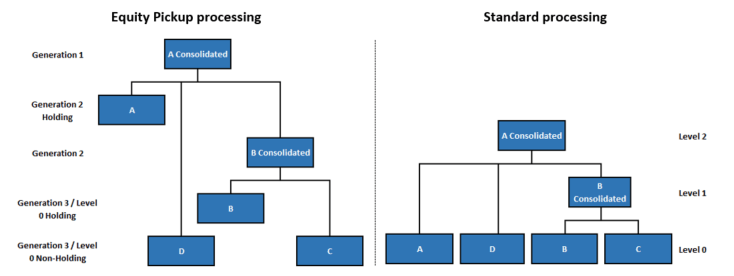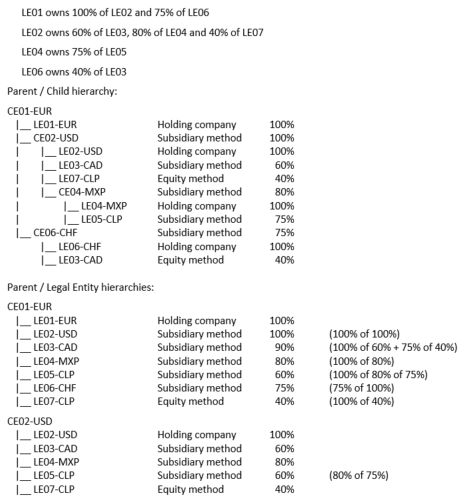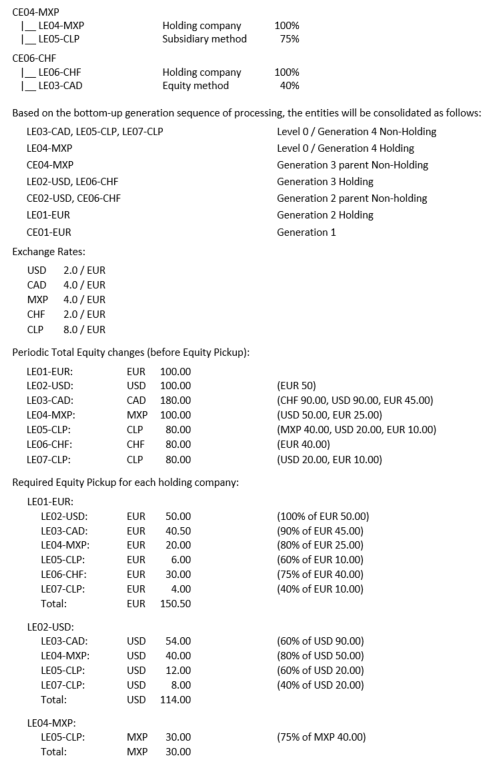Equity Pickup Processing
During a regular consolidation process, the calculation of entities is based on a bottom-up level-by-level approach starting from the lowest level of the entity hierarchy. The first group of entities to be calculated are all base (level 0) members (those entities that have no children). The next group to be processed are the level 1 parent entities (those entities with no more than one level of descendants below them). Then level 2 parents, and so on. This process ensures that all children of a parent entity are processed before that parent entity.
The sequence of processing required for correct Equity Pickup calculations is based instead on a bottom-up generation-by-generation approach. The top member is generation 0 and then each subsequent step down adds a generation. With this approach, each holding company is in the same generation as its siblings, whether those siblings are parent or base members. All level 0 non-holding entities are processed first. Then the highest generation of holding companies are processed, followed by the highest generation of parent entities, followed by the next highest generation of holding company entities and then the next highest generation of parent entities... and so on..
The following diagrams show the difference in processing in a very simple hierarchy (where legal company A owns legal companies B and D, and legal company B owns legal company C). Equity Pickup processes by generation from the bottom up. The standard sequencing processes by level from the bottom up:

Entities in scope for processing
Consolidation considers the calculation status of each entity when determining which entities are "in scope" for processing. When an entity is "Impacted", that entity needs to be re-calculated to take into account any changes that caused the impacting. In addition, all ancestors of the entity are also impacted because their results need to be re-calculated due to the re-calculation of an entity on which their results are dependent. Similarly, subsequent periods of the same scenario are also impacted.
Example 1 – data entry to entity C
For the standard consolidation process, if data is entered to entity C in the example above, then entities C, B Consolidated and A Consolidated are impacted. If A Consolidated is selected for consolidation, all three entities (C, B Consolidated and A Consolidated) will be re-calculated in sequence from level 0 to level 2.
For the Equity Pickup process, if data is entered to entity C, then entities C, B Consolidated and A Consolidated are all impacted, but in addition, entities B and A also need to be re-calculated because their data is dependent on the re-calculated data from entity C. If A Consolidated is selected for consolidation, all entities (C, B, B Consolidated, A and A Consolidated) will be re-calculated in sequence from Generation 3 to Generation 1.
Example 2 – data entry to entity A and entity C
For the standard consolidation process, if data is entered to entities A and C in the example above, then entities C, B Consolidated, A and A Consolidated are impacted. If A is selected for consolidation, only A will be re-calculated.
For the Equity Pickup process, if data is entered to entities A and C, then entities C, B Consolidated, A and A Consolidated are all impacted, but in addition, entity B also needs to be re-calculated because its data is dependent on the re-calculated data from entity C. If A is selected for consolidation, all entities except A Consolidated (C, B, B Consolidated and A) will be re-calculated in sequence from Generation 3 to Generation 2 Holding. Consolidating entity A brings B Consolidated and its impacted descendants into the scope of the consolidation process.
However, note that if no data is entered to A, selecting A for consolidation will not process a consolidation because A itself is not impacted. In this case, to update all entities, A Consolidated would need to be selected for consolidation as described in Example 1.
Example Equity Pickup calculation flow and required results
In order to ensure that when an Equity Pickup calculation is executed, the sibling source entity data has already been updated, entities need to be calculated in the required sequence as determined by the ownership chain.
Following is an example ownership chain:


